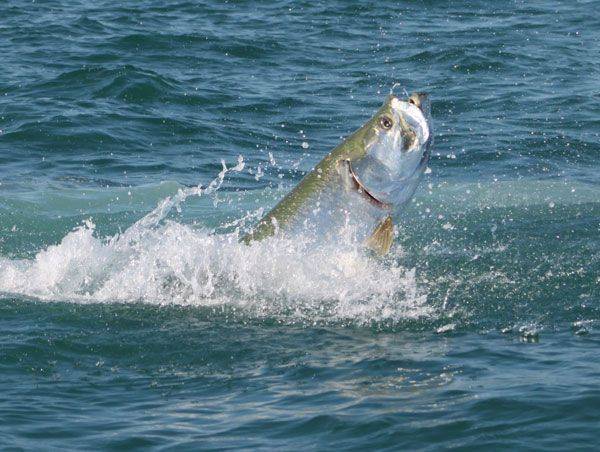By the FWC:
Have you ever felt the power of a large tarpon as it surges into the air and displays jaw-dropping acrobatics? Even for seasoned tarpon anglers, that first jump sends a rush of adrenaline through their veins like nothing else. Tarpon fishing in Florida has no equal, so it’s only natural that anglers from all over the country, and many other parts of the world, travel here to experience the challenge of catching and releasing a giant. Tarpon fishing is also extremely valuable to the state’s economy.
Techniques for tarpon fishing vary widely depending on geographic location and an angler’s personal preference. Fly-fishing is an extremely popular method in all areas, but you can also catch them by jigging, casting or trolling artificial lures, flat-lining a live bait, or by placing a frozen mullet, menhaden or other natural bait right on the bottom. What works well in one area may be ineffective in another, so it’s important to know how the knowledgeable anglers in the area are fishing.
Once you are lucky enough to hook a tarpon, the next challenge is keeping the fish on for the entire fight. Tarpons are very good at throwing the hook right back at you, so don’t be disappointed if you do not successfully leader a fish on the first few hook-ups.
As magnificent as tarpon are, they are also susceptible to population declines because they are slow-growing and late to become sexually mature. This means that if many tarpons are removed from the population – whether by people or predators – it takes a long time for the population to recover.

Regulations and Best Handling Practices
For starters, the tarpon is a catch-and-release-only fish. The only exception to this is if you are taking a tarpon for purposes of a new IGFA world record and have the required Florida Fish and Wildlife Conservation Commission (FWC) tarpon tag.
Because tarpon will fight to the point of exhaustion, FWC also established some common-sense handling requirements designed to increase tarpon survival rates. Large fish over 40 inches in length must remain in the water at all times, including when being de-hooked and photographed. While it’s natural to want a good photo of your catch, dragging a large tarpon onto a boat deck, pier or beach can be a death sentence for the fish. The goal should always be to keep the head and gills in the water as much as possible.
Following FWC’s fish-handling guidelines is also another good way to ensure tarpon survive to be caught another day. A tarpon exhausted from the fight is more likely to succumb to predation or die from other causes. You can help prevent this by using tackle that is heavy enough to land the fish quickly, and by reviving the fish by holding it horizontally in the water column with its mouth open while moving it forward.
Don’t tow a tarpon unless it is absolutely necessary to revive it. If you must tow, go as slow as possible while still moving water over the gills. And finally, do not fish for tarpon when large predatory sharks are in the area feeding. If sharks show up, move to another fishing location.
Learn more about these guidelines at MyFWC.com/Fishing by clicking on “Saltwater Fishing,” “Recreational Regulations” and “Fish Handling.”
Have a burning question about marine fisheries regulations? Want to know more about catch-and-release? We are here for you. Send your questions, photos and fishing tales to Saltwater@MyFWC.com. Make sure your photo meets our photo requirements by visiting MyFWC.com/Fishing and clicking on “Saltwater Fishing” and “Submit a photograph” under “Get Involved.” Don’t forget to record all of your catches on the iAngler phone app or at Snookfoundation.org. And learn how to submit your catches and get rewarded through our Saltwater Angler Recognition Programs at CatchaFloridaMemory.com.
The quarterly “Gone Coastal” column is one of many ways the FWC Division of Marine Fisheries Management is helping recreational anglers understand complex saltwater regulations and learn more about saltwater fishing opportunities and issues in Florida. We are also available to answer questions by phone or email anytime, and we would love the opportunity to share information through in-person presentations with recreational or commercial fishing organizations. To contact the FWC’s Regulatory Outreach subsection, call 850-487-0554 or email Saltwater@MyFWC.com.
